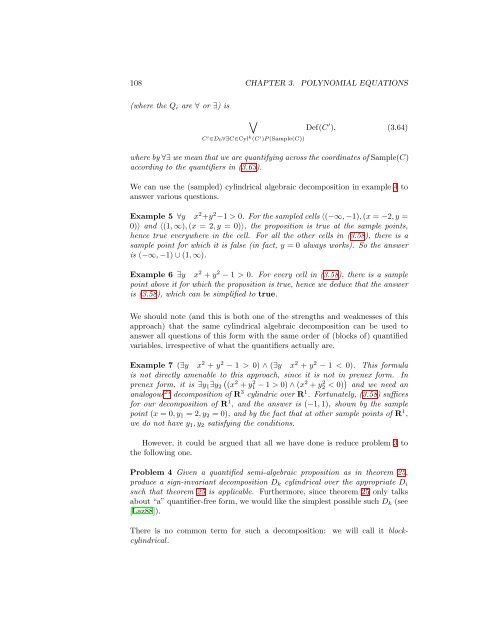Contents - Student subdomain for University of Bath
Contents - Student subdomain for University of Bath
Contents - Student subdomain for University of Bath
You also want an ePaper? Increase the reach of your titles
YUMPU automatically turns print PDFs into web optimized ePapers that Google loves.
108 CHAPTER 3. POLYNOMIAL EQUATIONS<br />
(where the Q i are ∀ or ∃) is<br />
∨<br />
C ′ ∈D 0∀∃C∈Cyl k (C ′ )P (Sample(C))<br />
Def(C ′ ), (3.64)<br />
where by ∀∃ we mean that we are quantifying across the coordinates <strong>of</strong> Sample(C)<br />
according to the quantifiers in (3.63).<br />
We can use the (sampled) cylindrical algebraic decomposition in example 4 to<br />
answer various questions.<br />
Example 5 ∀y x 2 +y 2 −1 > 0. For the sampled cells 〈(−∞, −1), (x = −2, y =<br />
0)〉 and 〈(1, ∞), (x = 2, y = 0)〉, the proposition is true at the sample points,<br />
hence true everywhere in the cell. For all the other cells in (3.58), there is a<br />
sample point <strong>for</strong> which it is false (in fact, y = 0 always works). So the answer<br />
is (−∞, −1) ∪ (1, ∞).<br />
Example 6 ∃y x 2 + y 2 − 1 > 0. For every cell in (3.58), there is a sample<br />
point above it <strong>for</strong> which the proposition is true, hence we deduce that the answer<br />
is (3.58), which can be simplified to true.<br />
We should note (and this is both one <strong>of</strong> the strengths and weaknesses <strong>of</strong> this<br />
approach) that the same cylindrical algebraic decomposition can be used to<br />
answer all questions <strong>of</strong> this <strong>for</strong>m with the same order <strong>of</strong> (blocks <strong>of</strong>) quantified<br />
variables, irrespective <strong>of</strong> what the quantifiers actually are.<br />
Example 7 (∃y x 2 + y 2 − 1 > 0) ∧ (∃y x 2 + y 2 − 1 < 0). This <strong>for</strong>mula<br />
is not directly amenable to( this approach, since it is not in prenex <strong>for</strong>m. In<br />
prenex <strong>for</strong>m, it is ∃y 1 ∃y 2 (x 2 + y1 2 − 1 > 0) ∧ (x 2 + y2 2 < 0) ) and we need an<br />
analogous 25 decomposition <strong>of</strong> R 3 cylindric over R 1 . Fortunately, (3.58) suffices<br />
<strong>for</strong> our decomposition <strong>of</strong> R 1 , and the answer is (−1, 1), shown by the sample<br />
point (x = 0, y 1 = 2, y 2 = 0), and by the fact that at other sample points <strong>of</strong> R 1 ,<br />
we do not have y 1 , y 2 satisfying the conditions.<br />
However, it could be argued that all we have done is reduce problem 3 to<br />
the following one.<br />
Problem 4 Given a quantified semi-algebraic proposition as in theorem 25,<br />
produce a sign-invariant decomposition D k cylindrical over the appropriate D i<br />
such that theorem 25 is applicable. Furthermore, since theorem 25 only talks<br />
about “a” quantifier-free <strong>for</strong>m, we would like the simplest possible such D k (see<br />
[Laz88]).<br />
we will call it block-<br />
There is no common term <strong>for</strong> such a decomposition:<br />
cylindrical.












![[Luyben] Process Mod.. - Student subdomain for University of Bath](https://img.yumpu.com/26471077/1/171x260/luyben-process-mod-student-subdomain-for-university-of-bath.jpg?quality=85)



